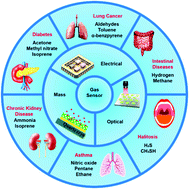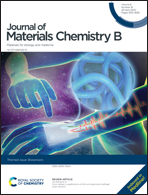Nanomaterial-based gas sensors used for breath diagnosis
Abstract
Gas-sensing applications commonly use nanomaterials (NMs) because of their unique physicochemical properties, including a high surface-to-volume ratio, enormous number of active sites, controllable morphology, and potential for miniaturisation. NM-based gas sensors, as a noninvasive, real-time technique, are a promising candidate for monitoring human breath. This review focuses on NM-based gas sensors used for breath diagnosis. First we describe some representative biomarkers of diseases that are detectable in breath and requirements for breath sensors. Then we review electrical, optical and mass-sensitive gas sensors in terms of these performance requirements, together with describing the detection capability of these sensors for trace concentrations of biomarkers and their initial attempts to diagnose disease. Moreover, we discuss breath sensor platforms with a multivariable sensing system, wireless communication and breath sampling, essential for predictive, preventive, personalised, and participatory (“P4”) medicine. Finally, we conclude with problems and challenges associated with the selectivity, humidity and validation of breath sensors. We hope that this article will inspire the development of high-performance gas sensors based on novel NMs.

- This article is part of the themed collections: Journal of Materials Chemistry B Lunar New Year collection 2021 and Biosensors


 Please wait while we load your content...
Please wait while we load your content...